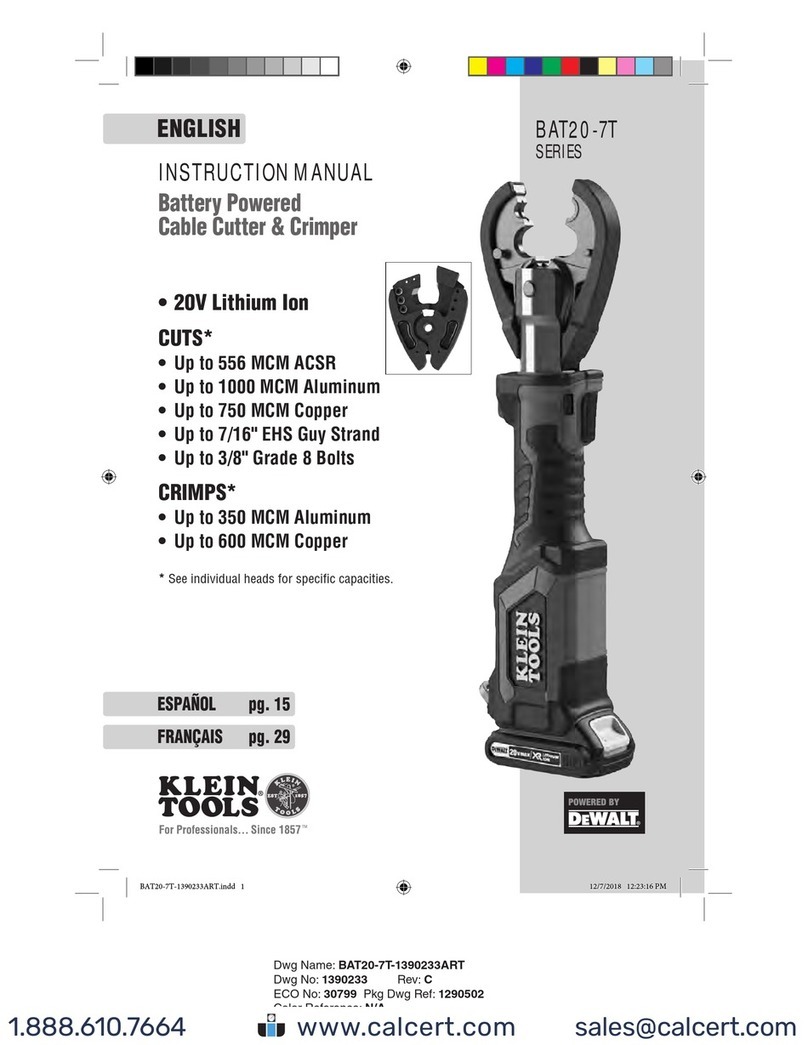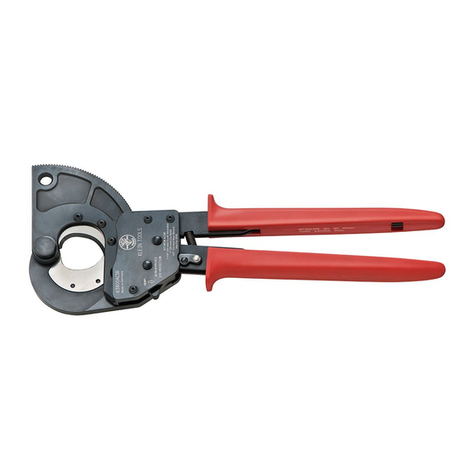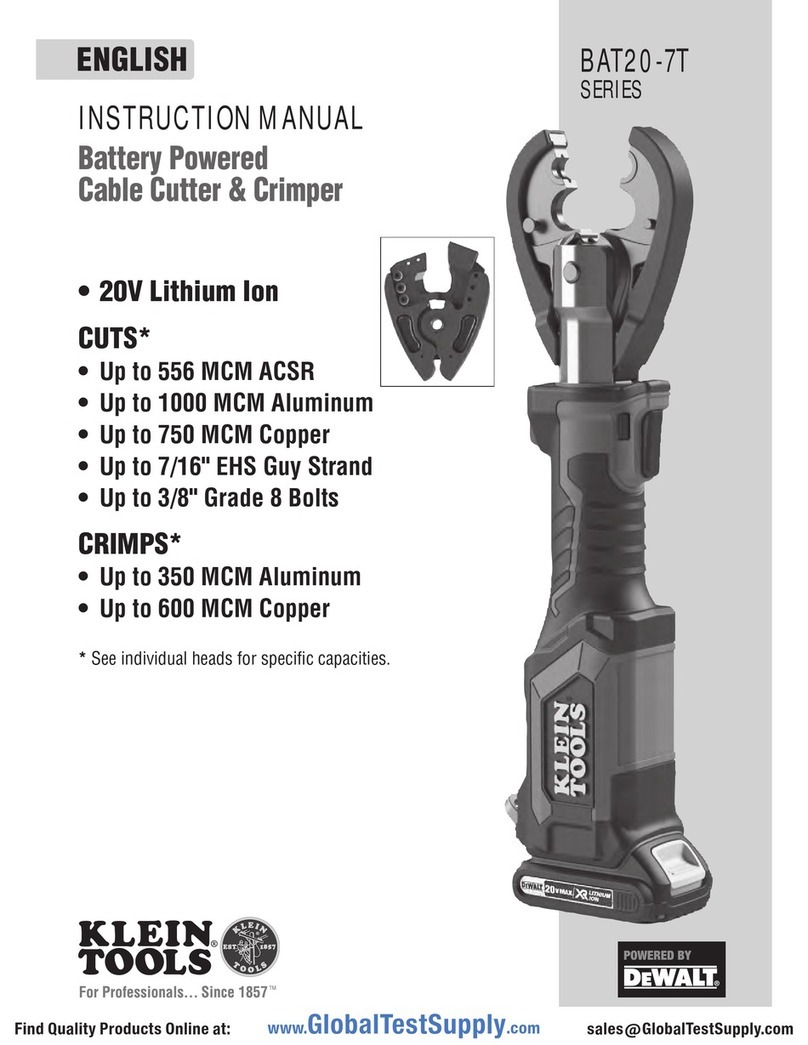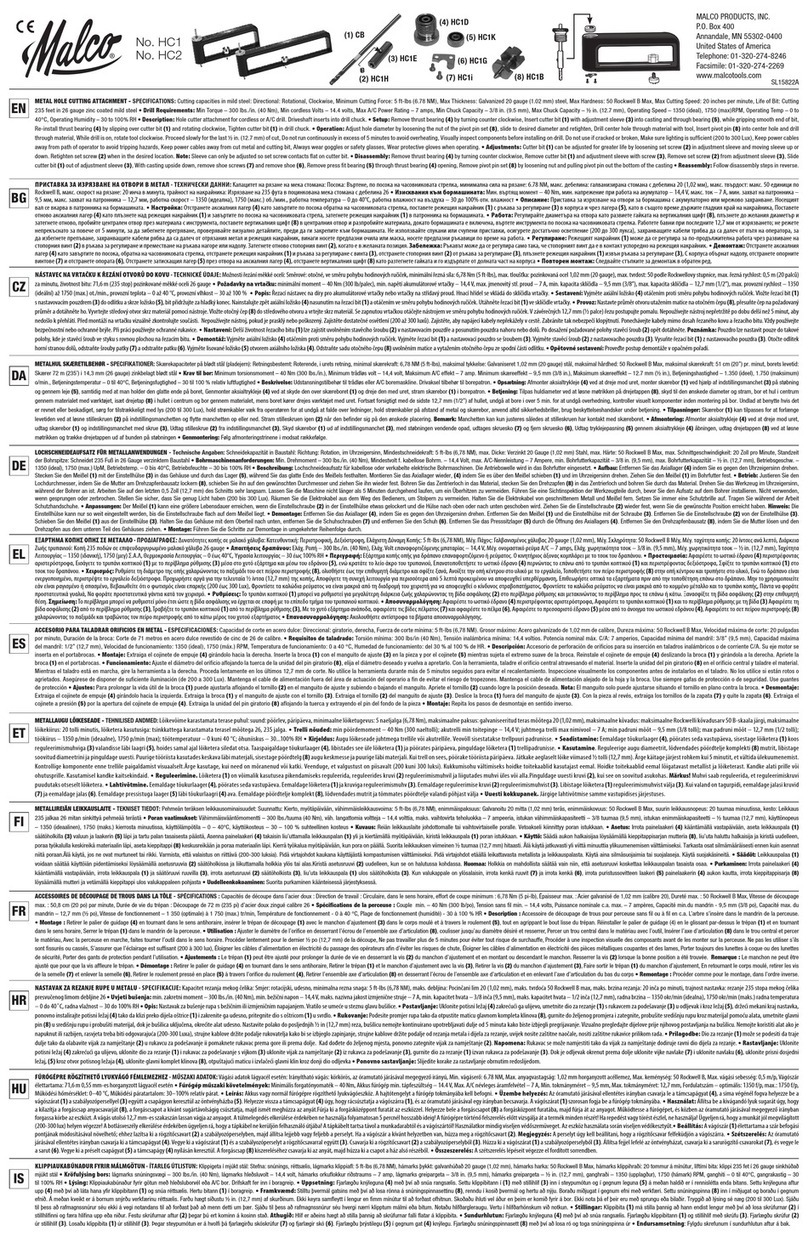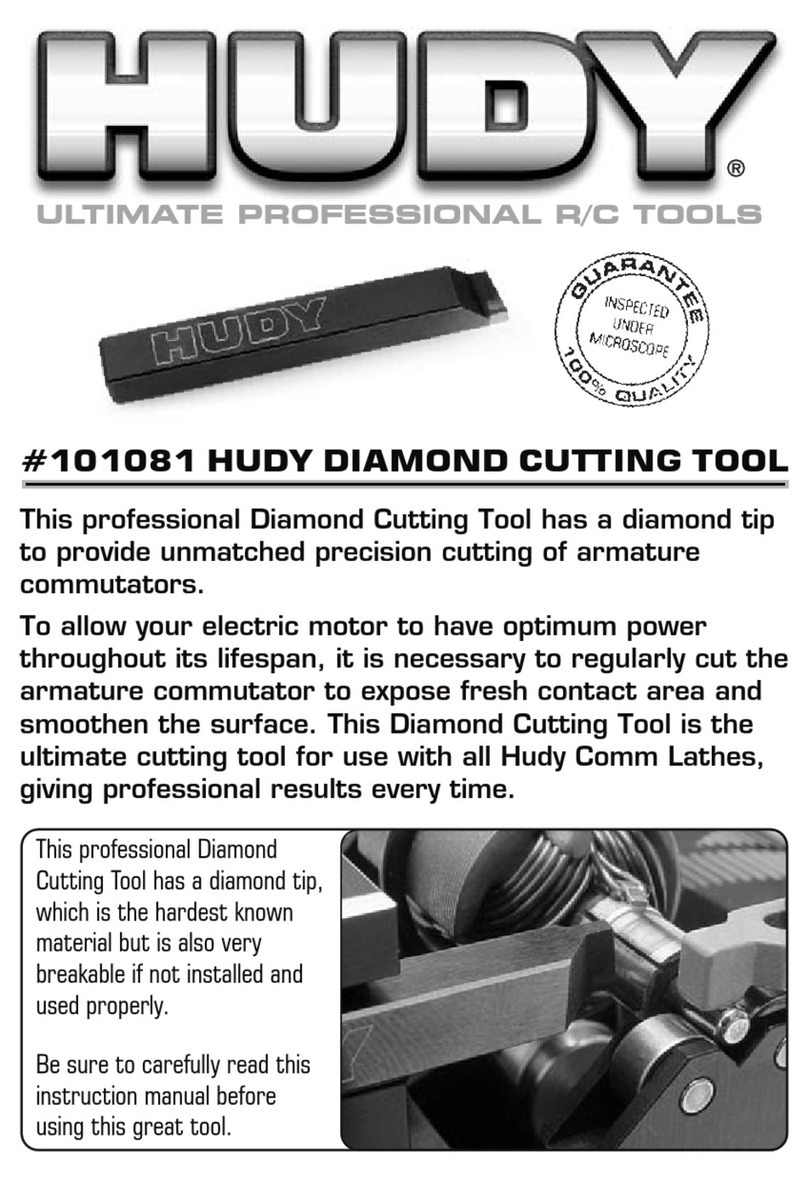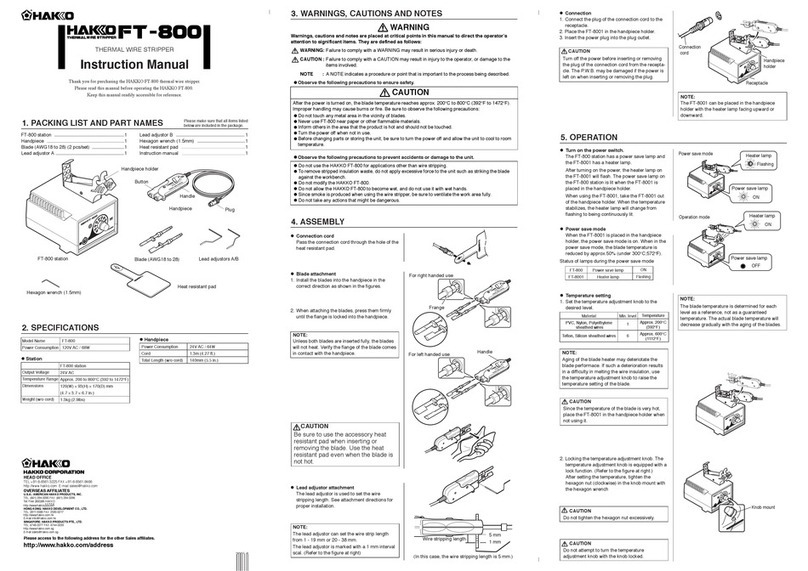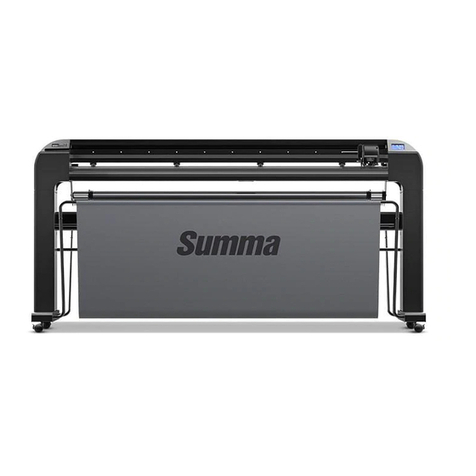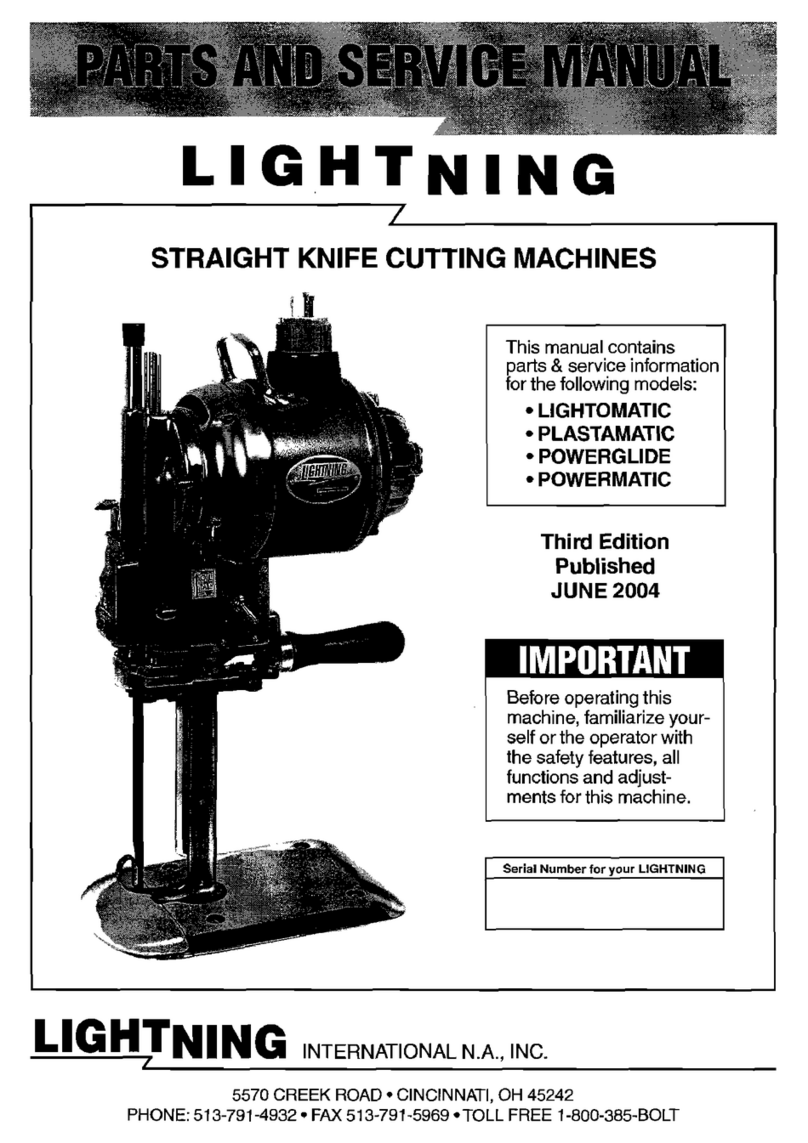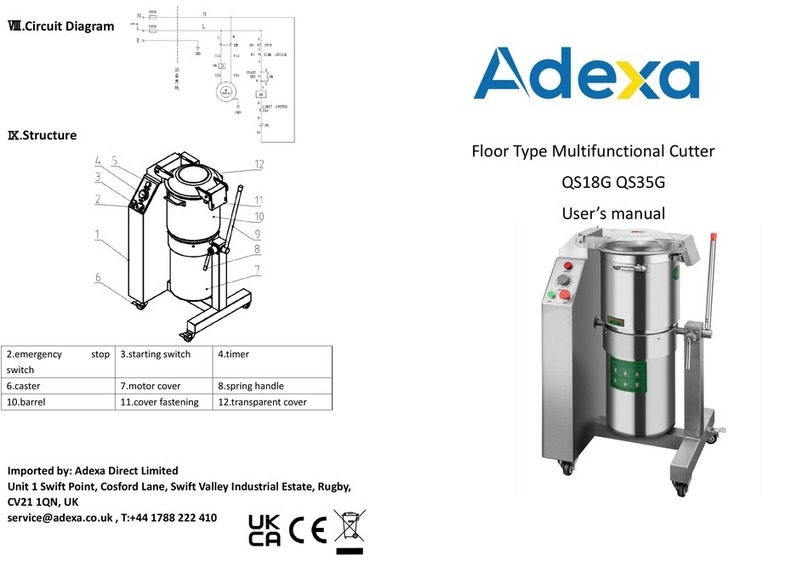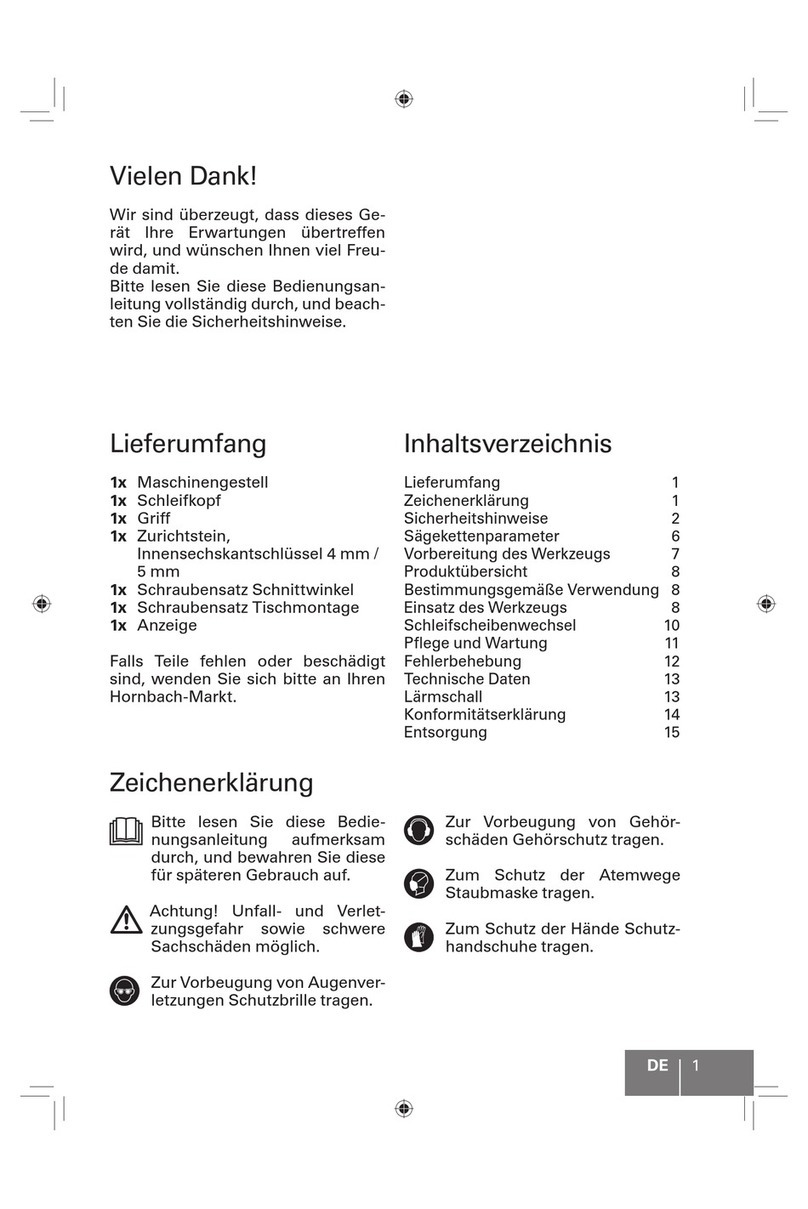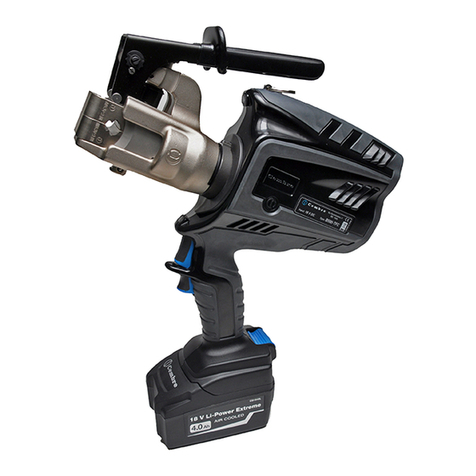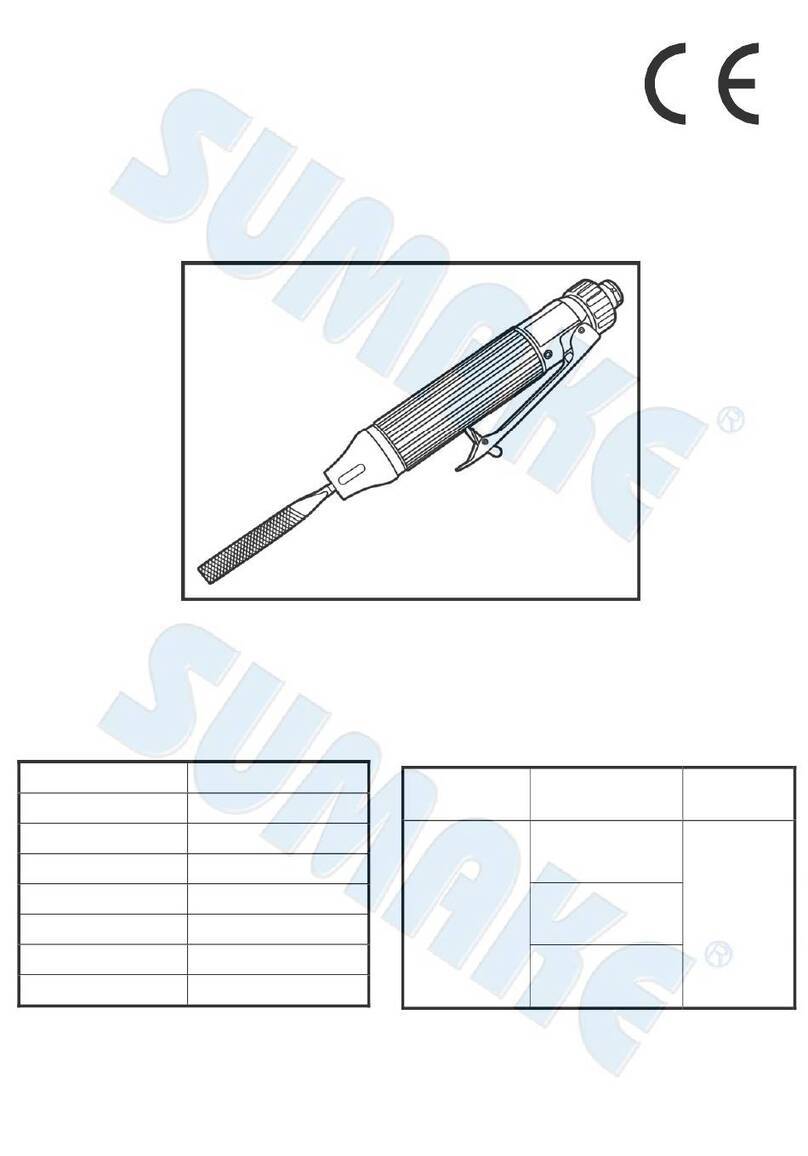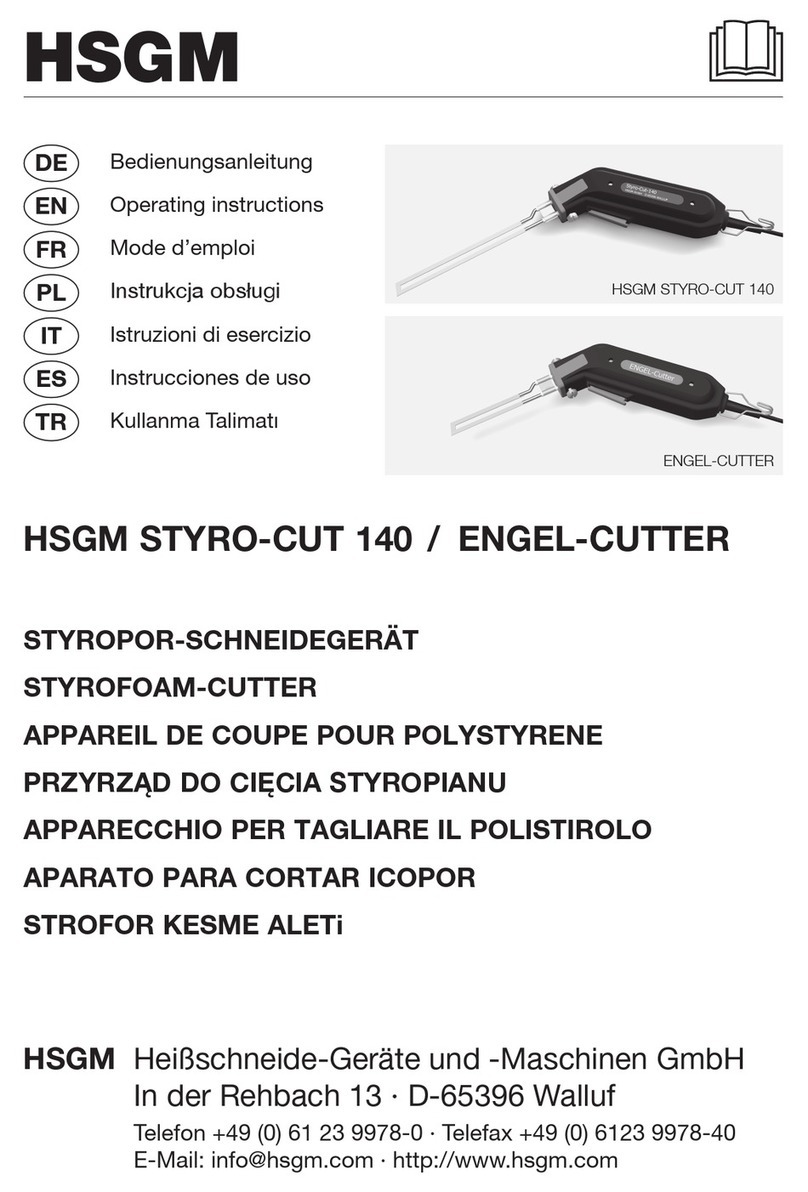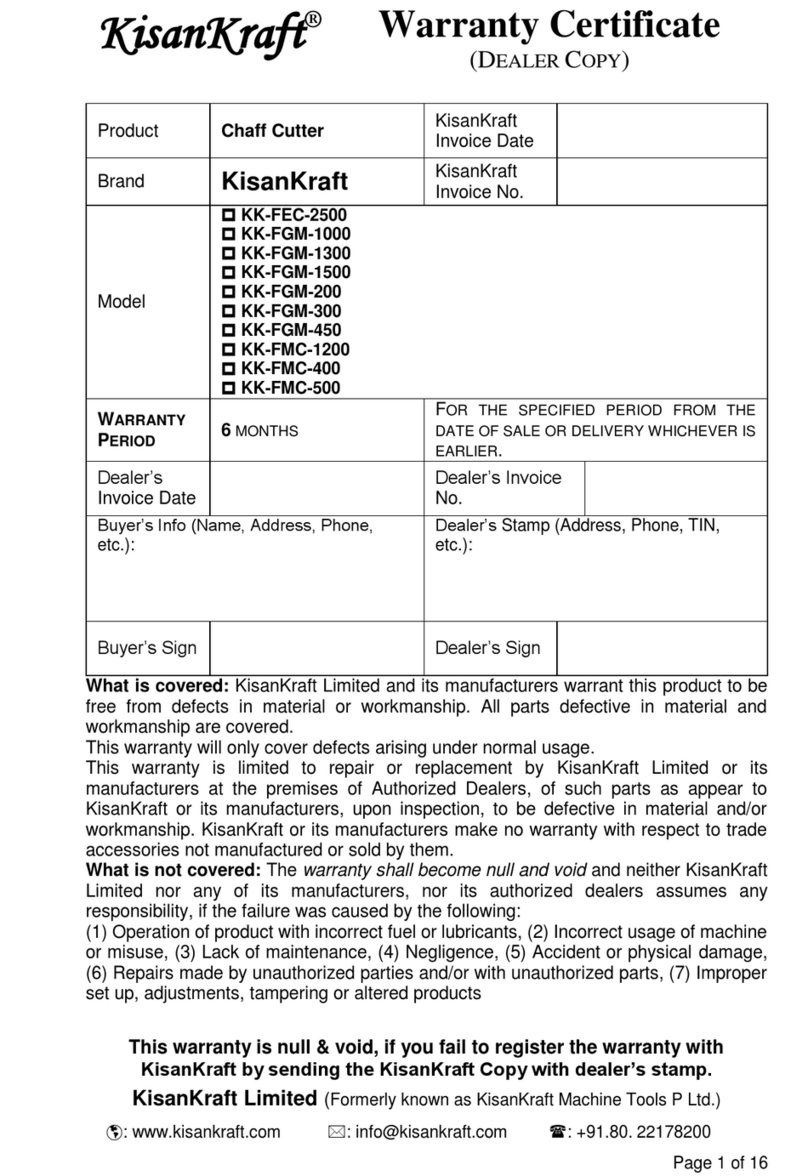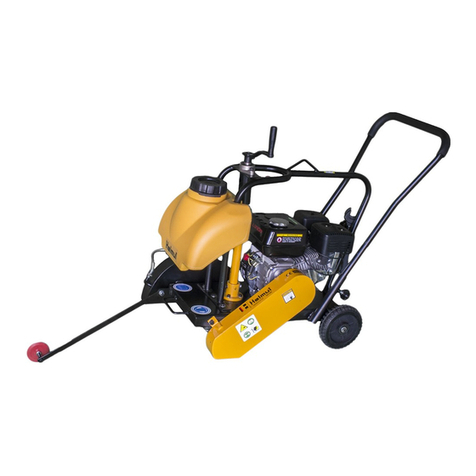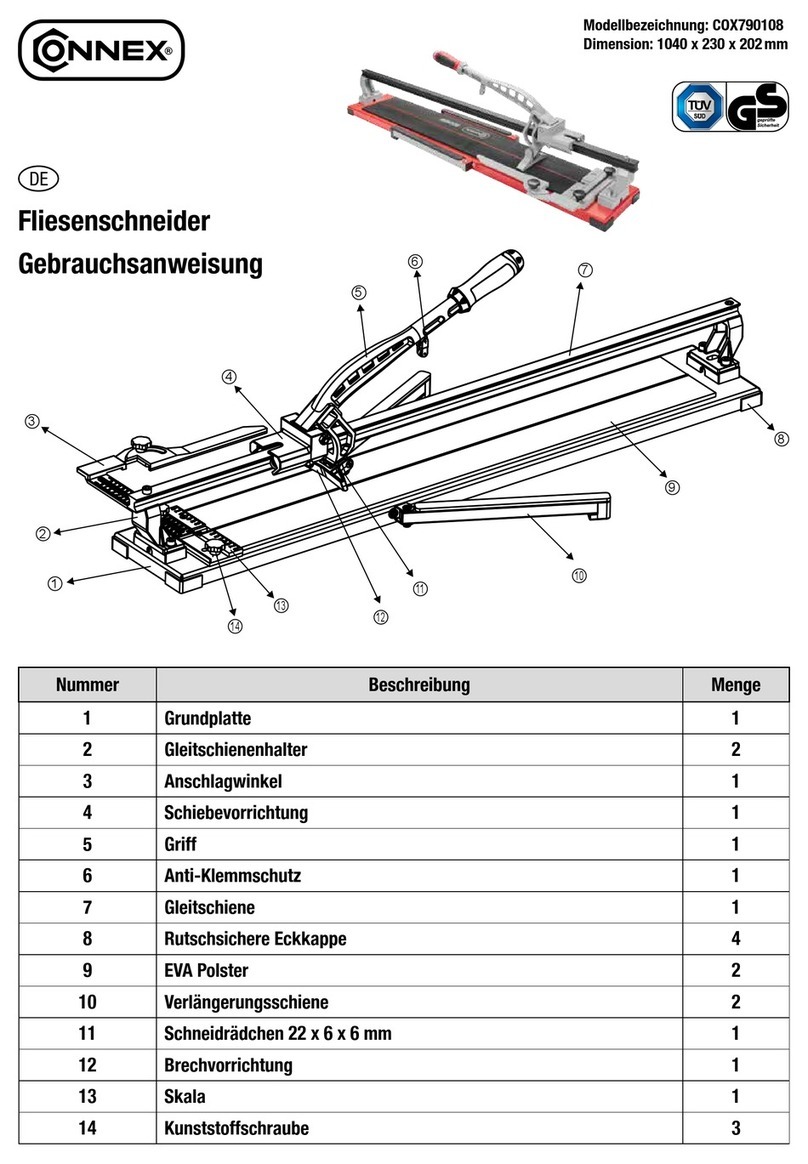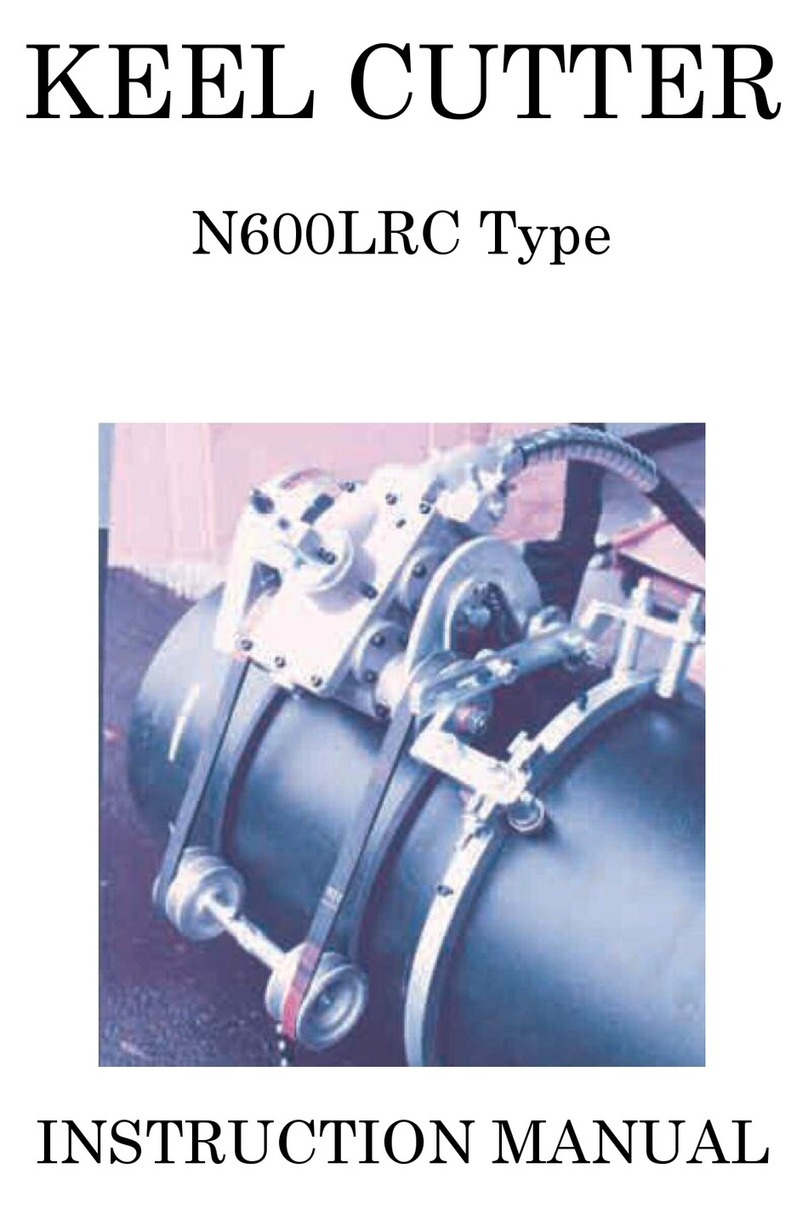Klein Tools BAT20-7T Series User manual

Dwg Name: BAT20-7T-1390233ART
Dwg No: 1390233 Rev: C
ECO No: 30799 Pkg Dwg Ref: 1290502
Color Reference: N/A
INSTRUCTION MANUAL
Battery Powered
Cable Cutter & Crimper
• 20V Lithium Ion
CUTS*
• Up to 556 MCM ACSR
• Up to 1000 MCM Aluminum
• Up to 750 MCM Copper
• Up to 7/16" EHS Guy Strand
• Up to 3/8" Grade 8 Bolts
CRIMPS*
• Up to 350 MCM Aluminum
• Up to 600 MCM Copper
*See individual heads for specific capacities.
BAT20-7T
SERIES
ENGLISH
FRANÇAIS pg. 29
ESPAÑOL pg. 15
BAT20-7T-1390233ART.indd 1 12/7/2018 12:23:16 PM

Dwg Name: BAT20-7T-1390233ART
Dwg No: 1390233 Rev: C
ECO No: 30799 Pkg Dwg Ref: 1290502
Color Reference: N/A
2
GENERAL SPECIFICATIONS
The Klein Tools BAT20-7T series tool line is a professional grade multi-function cutting and crimping tool designed to cut
and crimp the widest range of materials.
• Power Source: 20V Li-Ion battery
• Force: 7 Tons (14,000 lbs; 6,350 Kg)
• Operating Temperature: 14°F to 104°F (-10°C to 40°C)
Specifications subject to change.
1Trigger switch
2Trigger lock
3Release switch
4Crimp indicator light
5Main handle
6Head (interchangeable)
7Head release pin
8Battery pack
9Battery release button
10 Fuel gauge button
11 Lift ring
12 Side warning label
13 Worklights (x2)
NOTE: There are no user-serviceable parts inside tool.
Please contact Klein Tools for an authorized service center.
FEATURE DETAILS
ENGLISH
8
1
2
9
FRONT TOP
13
8
5
10
6
4
3
11
12
BACK
7
BAT20-7T-1390233ART.indd 2 12/7/2018 12:23:17 PM

Dwg Name: BAT20-7T-1390233ART
Dwg No: 1390233 Rev: C
ECO No: 30799 Pkg Dwg Ref: 1290502
Color Reference: N/A
3
AVAILABLE CUTTING & CRIMPING HEADS
CRIMPING HEADS
DBAT20-7T6 – BG and D3 (W-style die compatible)
EBAT20-7T12 – O and D3 (W-style die compatible)
FBAT20-7T7 – D3 (W-style die compatible)
D E F
CUTTING HEADS
ABAT20-7T10 – Aluminum, Copper, and ACSR
BBAT20-7T9 – Aluminum and Copper only
CBAT20-7T11 – Steel (Guy Strand and Bolts)
A B C
BAT20-7T-1390233ART.indd 3 12/7/2018 12:23:17 PM

Dwg Name: BAT20-7T-1390233ART
Dwg No: 1390233 Rev: C
ECO No: 30799 Pkg Dwg Ref: 1290502
Color Reference: N/A
4
DEFINITIONS
The definitions below describe the level of severity for each signal word used in this manual:
DANGER: Indicates an imminently hazardous situation which, if not avoided, will result in death or serious injury.
WARNING: Indicates a potentially hazardous situation which, if not avoided, could result in death or serious injury.
CAUTION: Indicates a potentially hazardous situation which, if not avoided, may result in minor or moderate injury.
NOTICE: Indicates a practice not related to personal injury which, if not avoided, may result in property damage.
WARNINGS
•DO NOT use under wet conditions or in presence of flammable liquids or gases.
•This is a professional power tool. DO NOT let children come into contact with the tool. Supervision is required
when inexperienced operators use this tool.
•Never modify the power tool or any part of it. Damage or personal injury could result.
SAFETY
To ensure safe operation and service of the drill, follow these instructions. Failure to observe these warnings can
result in electric shock, re, severe injury or death.
1) Work Area Safety
a) Keep work area clean and well lit. Cluttered or dark areas invite accidents.
b) Do not operate power tools in explosive atmospheres, such as in the presence of flammable liquids, gases or
dust. Power tools create sparks which may ignite the dust or fumes.
c) Keep children and bystanders away while operating a power tool. Distractions can cause you to lose control.
2) Electrical Safety
a) Avoid body contact with earthed or grounded objects. There is an increased risk of electric shock if your body is
earthed or grounded.
b) Do not expose power tools to rain or wet conditions. Water entering a power tool will increase the risk of
electric shock.
c) Do not abuse the battery charger cord. Never use the cord for carrying, pulling or unplugging. Keep cord away
from heat, oil, sharp edges or moving parts. Damaged or entangled cords increase the risk of electric shock.
d) When operating the battery charger outdoors, use an extension cord suitable for outdoor use. Use of a cord
suitable for outdoor use reduces the risk of electric shock.
e) If operating the battery charger in a damp location is unavoidable, use a ground fault circuit interrupter (GFCI)
protected supply. Use of a GFCI reduces the risk of electric shock.
3) Personal Safety
a) Stay alert, watch what you are doing and use common sense when operating a power tool. Do not use a power
tool while you are tired or under the influence of drugs, alcohol or medication. A moment of inattention while
operating power tools may result in serious personal injury.
b) Use personal protective equipment. Always wear eye protection. Protective equipment such as dust mask, non-
skid safety shoes, hard hat, or hearing protection used for appropriate conditions will reduce personal injuries.
c) Prevent unintentional starting. Ensure the trigger lock is engaged before connecting to battery pack, picking up
or carrying the tool. Carrying power tools with your finger on the switch invites accidents.
d) Do not overreach. Keep proper footing and balance at all times. This enables better control of the power tool in
unexpected situations.
e) Dress properly. Do not wear loose clothing or jewelry. Keep your hair, clothing and gloves away from moving
parts. Loose clothes, jewelry or long hair can be caught in moving parts.
ENGLISH
BAT20-7T-1390233ART.indd 4 12/7/2018 12:23:17 PM

Dwg Name: BAT20-7T-1390233ART
Dwg No: 1390233 Rev: C
ECO No: 30799 Pkg Dwg Ref: 1290502
Color Reference: N/A
5
SAFETY
4) Power Tool Use and Care
a) Do not force the power tool. Use the correct power tool for your application. The correct power tool will do the
job better and safer at the rate for which it was designed.
b) Remove the battery pack from the power tool before making any adjustments, changing accessories, or storing
power tools. Such preventive safety measures reduce the risk of starting the power tool accidentally.
c) Store idle power tools out of the reach of children and do not allow persons unfamiliar with the power tool or
these instructions to operate the power tool. Power tools are dangerous in the hands of untrained users.
d) Maintain power tools. Check for misalignment or binding of moving parts, breakage of parts and any other
condition that may affect the power tool’s operation. If damaged, have the power tool repaired before use. Many
accidents are caused by poorly maintained power tools.
e) Use the power tool, dies, accessories, etc. in accordance with these instructions, taking into account the
working conditions and the work to be performed. Use of the power tool for operations different from those
intended could result in a hazardous situation.
5) Battery Tool Use and Care
a) Recharge only with the charger specified by the manufacturer. A charger that is suitable for one type of battery
pack may create a risk of fire when used with another type of battery pack.
b) Use power tools only with specifically designated battery packs. Use of any other battery packs may create a
risk of injury and fire.
c) When battery pack is not in use, keep it away from other metal objects like paper clips, coins, keys, nails,
screws, or other small metal objects that can make connection from one terminal to another. Shorting the
battery terminals together may cause burns or a fire.
d) Under abusive conditions, liquid may be ejected from the battery; avoid contact. If contact accidentally occurs,
flush with water. If liquid contacts eyes, additionally seek medical help. Liquid ejected from the battery may
cause irritation or burns.
6) Service
a) Have your power tool serviced by a qualified repair person using only identical replacement parts. This will
ensure that the safety of the power tool is maintained. Contact Klein Tools for authorized service centers.
7) Additional Specic Safety Rules
ALWAYS use safety glasses. Everyday eyeglasses are NOT safety glasses.
8) Equipment
WARNING: Always wear proper personal hearing protection that conforms to ANSI S12.6 (S3.19) during use.
Under some conditions and duration of use, noise from this product may contribute to hearing loss.
CAUTION: When not in use, place tool on its side on a stable surface where it will not cause a tripping or falling
hazard. Some tools with large battery packs will stand upright on the battery pack but may be easily knocked over.
BAT20-7T-1390233ART.indd 5 12/7/2018 12:23:18 PM

Dwg Name: BAT20-7T-1390233ART
Dwg No: 1390233 Rev: C
ECO No: 30799 Pkg Dwg Ref: 1290502
Color Reference: N/A
6
SAFETY
9) Important Safety Instructions for All Battery Packs
•When ordering replacement battery packs, be sure to include the catalog number and voltage. Consult the chart
at the end of this manual for compatibility of chargers and battery packs.
•The battery pack is not fully charged out of the carton. Before using the battery pack and charger, read the safety
instructions below and then follow charging procedures outlined.
•DO NOT charge or use the battery pack in explosive atmospheres, such as in the presence of flammable liquids,
gases or dust. Inserting or removing the battery pack from the charger may ignite the dust or fumes.
•NEVER force the battery pack into the charger. Do not modify the battery pack in any way to fit into a non-
compatible charger as battery pack may rupture causing serious personal injury. Consult the chart at the end of
this manual for compatibility of batteries and chargers.
•Charge the battery packs only in designated DeWALT chargers.
•DO NOT splash or immerse in water or other liquids.
•DO NOT
store or use the tool and battery pack in locations where the temperature may reach or exceed 104°F (40°C)
(such as sheds or metal buildings in summer). For best life store battery packs in a cool, dry location.
NOTE:
Do not
store the battery packs in a tool.
•DO NOT incinerate the battery pack even if it is severely damaged or is completely worn out. The battery pack
can explode in a fire. Toxic fumes and materials are created when lithium ion battery packs are burned.
•If battery contents come into contact with the skin, immediately wash area with mild soap and water. If battery
liquid gets into the eye, rinse water over the open eye for 15 minutes or until irritation ceases. If medical attention
is needed, the battery electrolyte is composed of a mixture of liquid organic carbonates and lithium salts.
•Contents of opened battery cells may cause respiratory irritation. Provide fresh air. If symptoms persist, seek
medical attention.
WARNING: FIRE HAZARD. Never attempt to open the battery pack for any reason. If the battery pack case is
cracked or damaged, do not insert into the charger. Do not crush, drop or damage the battery pack. Do not use
a battery pack or charger that has received a sharp blow, been dropped, run over or damaged in any way (e.g.,
pierced with a nail, hit with a hammer, stepped on). Damaged battery packs should be returned to the service
center for recycling.
WARNING: FIRE HAZARD. Do not store or carry the battery pack so that metal objects can contact exposed
battery terminals. For example, do not place the battery pack in aprons, pockets, tool boxes, product kit boxes,
drawers, etc., with loose nails, screws, keys, etc. Transporting batteries can possibly cause fires if the battery
terminals inadvertently come in contact with conductive materials such as keys, coins, hand tools and the like. The
US Department of Transportation Hazardous Material Regulations (HMR) actually prohibit transporting batteries
in commerce or on airplanes (e.g., packed in suitcases and carry-on luggage) UNLESS they are properly protected
from short circuits. So when transporting individual battery packs, make sure that the battery terminals are
protected and well insulated from materials that could contact them and cause a short circuit.
WARNING: BURN HAZARD. Battery liquid may be flammable if exposed to spark or flame.
ENGLISH
BAT20-7T-1390233ART.indd 6 12/7/2018 12:23:18 PM

Dwg Name: BAT20-7T-1390233ART
Dwg No: 1390233 Rev: C
ECO No: 30799 Pkg Dwg Ref: 1290502
Color Reference: N/A
7
SAFETY
10) Important Safety Instructions for All Battery Chargers
WARNING: SHOCK HAZARD. Do not allow any liquid to get inside the charger. Electric shock may result.
CAUTION: BURN HAZARD. To reduce the risk of injury, charge only DeWALT rechargeable battery packs.
Other types of batteries may overheat and burst resulting in personal injury and property damage.
NOTICE: Under certain conditions, with the charger plugged into the power supply, the charger can be shorted
by foreign material. Foreign materials of a conductive nature, such as, but not limited to, grinding dust, metal
chips, steel wool, aluminum foil or any buildup of metallic particles should be kept away from the charger cavities.
Always unplug the charger from the power supply when there is no battery pack in the cavity. Unplug the charger
before attempting to clean.
•Before using the charger, read all instructions and cautionary markings on the charger, battery pack and product
using the battery pack.
•DO NOT attempt to charge the battery pack with any chargers other than the ones in this manual. The charger
and battery pack are specifically designed to work together.
•These chargers are NOT intended for any uses other than charging DeWALT rechargeable batteries. Any other
uses may result in risk of fire, electric shock or electrocution.
•DO NOT expose the charger to rain or snow.
•Pull by the plug rather than the cord when disconnecting the charger. This will reduce the risk of damage to the
electric plug and cord.
•Make sure that the cord is located so that it will not be stepped on, tripped over or otherwise subjected to
damage or stress.
•DO NOT place any object on top of the charger or place the charger on a soft surface that might block the
ventilation slots and result in excessive internal heat. Place the charger in a position away from any heat source.
The charger is ventilated through slots in the top and the bottom of the housing.
•DO NOT operate the charger with a damaged cord or plug.
•DO NOT operate the charger if it has received a sharp blow, been dropped or otherwise damaged in any way.
Take it to an authorized service center.
•DO NOT disassemble the charger; take it to an authorized service center when service or repair is required.
Incorrect reassembly may result in a risk of electric shock, electrocution or fire.
•Disconnect the charger from the outlet before attempting any cleaning. This will reduce the risk of electric
shock. Removing the battery pack will not reduce this risk.
•NEVER attempt to connect two chargers together.
•The charger is designed to operate on standard 120 volt household electrical power. Do not attempt to use any
other voltage. (This does not apply to vehicular chargers.)
•When operating a charger outdoors, always provide a dry location and use an extension cord suitable for
outdoor use. Use of a cord suitable for outdoor use reduces the risk of electric shock.
•DO NOT use an extension cord unless it is absolutely necessary. Use of improper extension cord could result in
risk of fire, electric shock or electrocution.
•An extension cord must have adequate wire size (AWG or American Wire Gauge) for safety. The smaller the
gauge number of the wire, the greater the capacity of the cable, that is, 16 gauge has more capacity than 18
gauge. An undersized cord will cause a drop in line voltage resulting in loss of power and overheating. When
using more than one extension to make up the total length, be sure each individual extension contains at least
the minimum wire size. The table below shows the correct size to use depending on cord length and nameplate
ampere rating. If in doubt, use the next heavier gauge. The lower the gauge number, the heavier the cord:
Minimum Gauge for Cord Sets
Ampere Rating (Amps)
Volts Total Length of Cord
120 V
25' (7.6 m) 50' (15.2 m) 100' (30.5 m) 150' (45.7 m)
240 V 50' (15.2) 100' (30.5) 200' (61.0) 300' (91.4)
More Than Not More Than AWG
0 6 18 16 16 14
610 18 16 14 12
10 12 16 16 14 12
12 16 14 12
Not Recommended
BAT20-7T-1390233ART.indd 7 12/7/2018 12:23:18 PM

Dwg Name: BAT20-7T-1390233ART
Dwg No: 1390233 Rev: C
ECO No: 30799 Pkg Dwg Ref: 1290502
Color Reference: N/A
8
SAFETY
11) Additional Specic Safety Rules
ALWAYS WEAR CERTIFIED SAFETY EQUIPMENT:
•ANSI Z87.1 eye protection (CAN/CSA Z94.3).
•ANSI S12.6 (S3.19) hearing protection.
•NIOSH/OSHA/MSHA respiratory protection.
•Wear safety goggles or other eye protection. Flying particles can cause permanent eye damage. ALWAYS use
safety glasses. Everyday eyeglasses are NOT safety glasses. Also use face or dust mask if cutting operation
is dusty.
•Accessories and tools get hot during operation. Wear gloves when touching them.
•Air vents often cover moving parts and should be avoided. Loose clothes, jewelry or long hair can be caught in
moving parts.
•Use clamps or other practical way to secure and support the workpiece to a stable platform. Holding the work
by hand or against your body is unstable and may lead to loss of control.
BATTERY CHARGING INSTRUCTIONS
Battery Charger Models DCB107, DCB112, DCB113, DCB115
•This Class B digital apparatus complies with Canadian ICES-003.
•This device complies with Part 15 of the FCC Rules and Industry Canada License exempt RSS standard(s).
Operation is subject to the following two conditions:
1) This device may not cause harmful interference, and
2) This device must accept any interference received, including interference that may cause undesired operation.
NOTE: This equipment has been tested and found to comply with the limits for a Class B digital device, pursuant to
Part 15 of the FCC Rules. These limits are designed to provide reasonable protection against harmful interference
in a residential installation. This equipment generates, uses and can radiate radio frequency energy and, if not
installed and used in accordance with the instructions, may cause harmful interference to radio communications.
However, there is no guarantee that interference will not occur in a particular installation. If this equipment does
cause harmful interference to radio or television reception, which can be determined by turning the equipment off
and on, the user is encouraged to try to correct the interference by one or more of the following measures:
•Reorient or relocate the receiving antenna.
•Increase the separation between the equipment and receiver.
•Connect the equipment into an outlet on a circuit different from that to which the receiver is connected.
•Consult the dealer or an experienced radio/TV technician for help.
Changes or modifications not expressly approved by the party responsible for compliance could void the user’s
authority to operate the equipment.
Battery Charging
Your tool uses a DeWALT charger. Be sure to read all safety instructions before
using your charger.
1. Plug the charger into an appropriate outlet before inserting the battery pack.
2. Insert the battery pack
6
into the charger, making sure the pack is fully seated
in charger. The red light will blink continuously, indicating the charging process
has started.
3. The completion of charge will be indicated by the red light remaining ON
continuously. The pack is fully charged and may be used at this time or left
in the charger.
8
ENGLISH
BAT20-7T-1390233ART.indd 8 12/7/2018 12:23:18 PM

Dwg Name: BAT20-7T-1390233ART
Dwg No: 1390233 Rev: C
ECO No: 30799 Pkg Dwg Ref: 1290502
Color Reference: N/A
9
BATTERY CHARGING INSTRUCTIONS
Charge Indicators
Your charger is designed to detect certain problems that can arise. Problems are indicated by the red light flashing
at a fast rate. If this occurs, re-insert the battery pack into the charger. If the problem persists, try a different
battery pack to determine if the charger is working properly. If the new pack charges correctly, then the original
pack is defective and should be returned to a service center or other collection site for recycling. If the new
battery pack elicits the same trouble indication as the original, have the charger and the battery pack tested at an
authorized service center.
Your charger has the following indicators: Pack Charging, Pack Charged, Hot/Cold Delay.
HOT/COLD DELAY: The above model chargers have a hot/cold delay feature. When the charger detects a battery
that is too hot or too cold, it automatically starts a delay, suspending charging. The red light will continue to blink,
but a yellow indicator light will be illuminated during this suspension. Once the battery has reached an optimum
temperature, the yellow light will turn off and the charger will automatically resume the charging procedure. This
feature ensures maximum battery life.
LEAVING THE BATTERY PACK IN THE CHARGER: The charger and battery pack can be left connected with the
charge indicator showing Pack Charged.
WEAK BATTERY PACKS: Weak batteries will continue to function but should not be expected to perform as much work.
FAULTY BATTERY PACKS
These chargers will
not
charge a faulty battery pack. The charger will indicate faulty battery pack by refusing to
light. NOTE: This could also indicate a problem with the charger.
WALL MOUNTING
These chargers are designed to be wall mountable or to sit upright on a table or work surface. If wall mounting,
locate the charger within reach of an electrical outlet. Mount the charger securely using drywall screws at least 1"
(25.4 mm) long, screwed into wood to an optimal depth leaving approximately 7/32" (5.5 mm) of the screw exposed.
IMPORTANT CHARGING NOTES
1. Longest life and best performance can be obtained if the battery pack is charged when the air temperature is
between 65 °F and 75 °F (18 °–24 °C). DO NOT charge the battery pack in an air temperature below 40 °F (4.5 °C),
or above 104 °F (40 °C). This is important and will prevent serious damage to the battery pack.
2. The charger and battery pack may become warm to the touch while charging. This is a normal condition, and does
not indicate a problem. To facilitate the cooling of the battery pack after use, avoid placing the charger or battery
pack in a warm environment such as in a metal shed or an uninsulated trailer.
3. A cold battery pack will charge at about half the rate of a warm battery pack. The battery pack will charge at a
slower rate throughout the entire charging cycle and will not return to maximum charge rate even if the battery
pack warms.
4. If the battery pack does not charge properly:
a. Check operation of receptacle by plugging in a lamp or other appliance;
b. Check to see if receptacle is connected to a light switch which turns power off when you turn out the lights;
c. Move the charger and battery pack to a location where the surrounding air temperature is approximately
65 °F–75 °F (18 °–24 °C);
d. If charging problems persist, take the tool, battery pack and charger to your local DeWALT service center.
5. The battery pack should be recharged when it fails to produce sufficient power on jobs which were easily done
previously. DO NOT CONTINUE to use under these conditions. Follow the charging procedure. You may also
charge a partially used pack whenever you desire with no adverse effect on the battery pack.
6. Foreign materials of a conductive nature such as, but not limited to, grinding dust, metal chips, steel wool,
aluminum foil, or any buildup of metallic particles should be kept away from charger cavities. Always unplug the
charger from the power supply when there is no battery pack in the cavity. Unplug the charger before attempting
to clean.
7. DO NOT freeze or immerse the charger in water or any other liquid.
BAT20-7T-1390233ART.indd 9 12/7/2018 12:23:18 PM

Dwg Name: BAT20-7T-1390233ART
Dwg No: 1390233 Rev: C
ECO No: 30799 Pkg Dwg Ref: 1290502
Color Reference: N/A
10
For more information regarding fuel gauge battery packs, please call 1-800-4-DeWALT (1-800-433-9258) or visit
www.dewalt.com.
BATTERY CHARGING INSTRUCTIONS
WARNING: SHOCK HAZARD. DO NOT allow any liquid to get inside the charger. Electric shock may result.
WARNING: BURN HAZARD. DO NOT submerge the battery pack in any liquid or allow any liquid to enter the
battery pack. Never attempt to open the battery pack for any reason. If the plastic housing of the battery pack
breaks or cracks, return to a service center for recycling.
INSTALLING & REMOVING BATTERY PACK
NOTE:
For best results, make sure your battery pack is fully charged.
• To install the battery pack
4
into the tool, align the battery pack with the rails inside the tool’s handle and slide
it into the handle until the battery pack is firmly seated in the tool and ensure that it does not disengage.
• To remove the battery pack from the tool, press the release button
5
and firmly pull the battery pack out of the
tool handle. Insert it into the charger as described in the charger section of this manual.
NOTE:
After removing the battery pack, squeeze the trigger for three seconds to dissipate any electric charge that
may still be in the tool.
FUEL GAUGE BATTERY PACKS
10
Some DeWALT battery packs include a fuel gauge which consists of three green LED lights that indicate the level of
charge remaining in the battery pack. To actuate the fuel gauge, press and hold the fuel gauge button. A combination
of the three green LED lights will illuminate, designating the level of charge left. When the level of charge in the
battery is below the usable limit, the fuel gauge will not illuminate and the battery will need to be recharged.
NOTE:
The fuel gauge is only an indication of the approximate charge left on the battery pack, according to
the indicators shown here. It does
not
indicate tool functionality and is subject to variation based on product
components, temperature and end-user application.
For more information regarding fuel gauge battery packs, please call 1-800-4-DeWALT (1-800-433-9258) or visit
www.dewalt.com.
75 – 100% charged
51 – 74% charged
<50% charged
Pack needs to be charged
8
9
10
ENGLISH
BAT20-7T-1390233ART.indd 10 12/7/2018 12:23:19 PM

Dwg Name: BAT20-7T-1390233ART
Dwg No: 1390233 Rev: C
ECO No: 30799 Pkg Dwg Ref: 1290502
Color Reference: N/A
11
OPERATING INSTRUCTIONS
• Inspect the tool before and after every use. Do not use this tool if it is damaged in any way.
• Personal injury can be caused by operating poorly maintained tools. Check for loose parts before using.
• Ensure the fitting is not over-specification. You may damage the tool if you do not follow the operating instructions.
Use the die specified by connector manufacturer for you specific application.
• Remove battery pack while servicing, replacing dies, or storing the tool.
• Do not use the tool if there are any abnormalities or damage to any of its components
• Suggested working temperatures: 14°F to 104°F (-10°C to 40°C). Check hydraulic fluid specifications.
• Hydraulic fluid temperatures over 149°F (65°C) might soften packings and seals and cause fluid leaks.
• Inform authorized distributors or contact Klein Tools in case of any abnormalities or malfunctions of the product.
TRIGGER SWITCH
1
:Press the Trigger Switch to advance crimping piston and hold until the
dies have fully compressed connector or cut through cable.
TRIGGER LOCK
2
:Restricts the Trigger Lock
1
from activating.
RELEASE SWITCH
3
:
Press the Release Button to release hydraulic pressure and retract the
piston. The tool is designed to retract the piston only after complete 7 ton crimp is achieved.
Once the crimp cycle has started, the retract button will not function until the cycle is completed.
QUICK-RELEASE HEADS:
WARNING: Remove battery pack before removing or replacing heads.
1. To exchange heads, twist head release pin 1/4 turn. The pin will stay in the tool while you
replace the heads.
2. To lock new head in tool, push pin and twist 1/4 turn. NOTE: If head release pin is not
properly installed and locked, there is a potential to bend and damage the tool during use.
CUTTING BLADE REPLACEMENT:
1. If necessary, remove the battery pack and release the head from the tool.
2. Loosen hex screws and remove old cutting blades.
3. Insert new cutting blades in reverse order and tighten hex screws. NOTE: For optimal performance, use a drop of
thread lock adhesive on hex head screws.
CRIMP INDICATOR LIGHT
4
:
1. The LED light will illuminate
GREEN
when the tool has reached full 7-ton pressure and a crimp has been
successfully completed.
2. When this tool is operated correctly, it takes approximately seven (7) seconds to complete
one full cycle and complete a compression. If the tool is used for 10 seconds and does not
reach full 7Ton pressure, the tool motor will stop. If the green LED is not lit, this indicates
there is a problem with the tool.
DO NOT attempt to repair; please contact an authorized
Klein Tools service center to repair the tool.
LIFT RING
11
:The lift ring is intended for moving the tool into hard-to-reach areas. Securely
fasten lifting device to the ring before moving the tool. Follow all worksite rules.
WARNING: To reduce the risk of serious personal injury, DO NOT use the
lift ring for tethering or securing the tool to a person or object during use when elevated.
1
2
3
7
4
11
BAT20-7T-1390233ART.indd 11 12/7/2018 12:23:19 PM

Dwg Name: BAT20-7T-1390233ART
Dwg No: 1390233 Rev: C
ECO No: 30799 Pkg Dwg Ref: 1290502
Color Reference: N/A
12
ENGLISH
MAINTENANCE
• Have your power tool serviced by a qualified repair person using only identical replacement parts. This will
ensure that the safety of the power tool is maintained. Contact Klein Tools for authorized service centers. Visit
www.kleintools.com for service manual and replacement part list.
• The charger and battery pack are NOT serviceable. To assure product safety and reliability, repairs, maintenance
and adjustments should be performed by a DeWALT factory service center, a DeWALT authorized service center
or other qualified service personnel. Always use identical replacement parts.
• Use only Shell Telus T15 or an equivalent hydraulic fluid when changing or adding oil.
• Inform Klein Tools authorized distributors or contact Klein Tools in case of any abnormalities or malfunctions of
the product.
Shell®and Tellus®are registered trademarks of Shell Trademark Management B.V.
CLEANING
Tool:
• Blow dirt and dust out of all air vents with clean, dry air at least once a week. To minimize the risk of eye injury,
always wear ANSI Z87.1 approved eye protection when performing this.
• Never use solvents or other harsh chemicals for cleaning the non-metallic parts of the tool. These chemicals
may weaken the plastic materials used in these parts. Use a cloth dampened only with water and mild soap.
Never immerse any part of the tool into a liquid.
Charger:
WARNING: SHOCK HAZARD. Disconnect the charger from the AC outlet before cleaning. Dirt and grease may
be removed from the exterior of the charger using a cloth or soft non-metallic brush. DO NOT use water or any
cleaning solutions.
STORAGE
The best storage place is one that is cool and dry, away from direct sunlight and excess heat or cold. For
prolonged storage, it is recommended to store a fully charged battery pack in a cool, dry place out of the charger
for optimal results.
NOTE:
Battery packs should not be stored completely depleted of charge. The battery pack will
need to be recharged before use.
WARRANTY – TOOL
Klein Tools Battery Operated Tools, manufactured and sold for commercial or industrial uses, are warranted to be free
from defects in materials and workmanship.
THERE ARE NO IMPLIED WARRANTIES OF MERCHANTIBILITY OR FITNESS. At its option, Klein will repair, replace, or
refund the purchase price of any product which fails to conform to this warranty under normal use and service. There are
no user serviceable parts in this tool. This warranty does not apply if repairs have been made or attempted by non-Klein
Tools Authorized Repair Centers, if alterations have been made, or if the tool has been abused or misused.
IN NO EVENT SHALL KLEIN TOOLS BE LIABLE FOR INCIDENTAL OR CONSEQUENTIAL DAMAGE. Some states do not allow
exclusion or limitation of incidental or consequential damages, so the above limitation or exclusion may not apply to you.
See www.kleintools.com/warranty for additional information.
WARRANTY – CHARGERS AND BATTERY PACKS
DeWALT chargers are covered by:
Three Year Limited Warranty: DeWALT will repair, without charge, any defects due to faulty materials or
workmanship for three years from the date of purchase. This warranty does not cover part failure due to normal
wear or tool abuse. For further detail of warranty coverage and warranty repair information, visit www.dewalt.com
or call 1-800-4-DeWALT (1-800-433-9258). This warranty does not apply to accessories or damage caused where
repairs have been made or attempted by others. This warranty gives you specific legal rights and you may have
other rights which vary in certain states or provinces.
DeWALT battery packs are covered by:
Two Years free service on Packs:
DCB201, DCB203, DCB203BT, DCB207.
Three Years free service on Packs:
DCB200, DCB204, DCB204BT, DCB205.
Product warranty voided if the battery pack is tampered with in any way. DeWALT is not responsible for any injury
caused by tampering and may prosecute warranty fraud to the fullest extent permitted by law.
For more information on DeWALT service or warranties, visit www.dewalt.com or
call 1-800-4-DeWALT
(1-800-433-9258).
BAT20-7T-1390233ART.indd 12 12/7/2018 12:23:19 PM

Dwg Name: BAT20-7T-1390233ART
Dwg No: 1390233 Rev: C
ECO No: 30799 Pkg Dwg Ref: 1290502
Color Reference: N/A
13
CUSTOMER SERVICE
KLEIN TOOLS, INC.
450 Bond Street Lincolnshire, IL 60069 1-844-395-3235
[email protected] www.kleintools.com
THE RBRC™ SEAL
The RBRC™ (Rechargeable Battery Recycling Corporation) Seal on the nickel cadmium, nickel metal
hydride or lithium ion batteries (or battery packs) indicate that the costs to recycle these batteries (or
battery packs) at the end of their useful life have already been paid. In some areas, it is illegal to place
spent nickel cadmium, nickel metal hydride or lithium ion batteries in the trash or municipal solid waste
stream and the RBRC program provides an environmentally conscious alternative.
RBRC™ has established programs in the United States and Canada to facilitate the collection of spent
nickel cadmium, nickel metal hydride or lithium ion batteries. Help protect our environment and conserve
natural resources by returning the spent nickel cadmium, nickel metal hydride or lithium
ion batteries to an authorized DeWALT service center or to your local retailer for recycling.
You may also contact your local recycling center for information on where to drop off the
spent battery RBRC™ is a registered trademark of the Rechargeable Battery Recycling
Corporation.
WARNING: EXPLOSION HAZARD.
DO NOT INCINERATE BATTERY PACK.
DISPOSAL
Do not place equipment and its accessories in the trash. Items must be properly
disposed of in accordance
with local regulations. Please see www.epa.gov or www.erecycle.org for additional information.
DEWALT and the DEWALT logo are trademarks of Stanley Black & Decker, Inc, or an afliate thereof and are
used under license.
BAT20-7T-1390233ART.indd 13 12/7/2018 12:23:20 PM

Dwg Name: BAT20-7T-1390233ART
Dwg No: 1390233 Rev: C
ECO No: 30799 Pkg Dwg Ref: 1290502
Color Reference: N/A
KLEIN TOOLS, INC.
450 Bond Street Lincolnshire, IL 60069
1-877-775-5346
[email protected] www.kleintools.com
ESPAÑOL
NOTES
BAT20-7T-1390233ART.indd 14 12/7/2018 12:23:20 PM

Dwg Name: BAT20-7T-1390233ART
Dwg No: 1390233 Rev: C
ECO No: 30799 Pkg Dwg Ref: 1290502
Color Reference: N/A
15
MANUAL DE INSTRUCCIONES
Cortador y ponchador
multicable a baterías
• Batería de ion de litio
de20V
CORTA*
• Cables ACSR de hasta 556 MCM
• Cables de aluminio de hasta 1000 MCM
• Cables de cobre de hasta 750 MCM
• Cables de acero trenzado de alta
resistencia de hasta7/16"
• Tornillos de grado 8 de hasta 3/8"
PONCHA*
• Cables de aluminio de hasta 350 MCM
• Cables de cobre de hasta 600 MCM
*Vea las cabezas individuales para conocer las capacidades
específicas.
SERIE
BAT20-7T
ESPAÑOL
BAT20-7T-1390233ART.indd 15 12/7/2018 12:23:20 PM

Dwg Name: BAT20-7T-1390233ART
Dwg No: 1390233 Rev: C
ECO No: 30799 Pkg Dwg Ref: 1290502
Color Reference: N/A
16
ESPECIFICACIONES GENERALES
La BAT20-7T de Klein Tools es una herramienta de corte y ponchado multifunción de grado profesional diseñada para
cortar y ponchar la más amplia variedad de materiales.
• Fuente de energía: batería de ion de litio de 20V
• Fuerza: 7 toneladas (14000lb; 6350kg)
• Temperatura de operación: 14°F a 104°F (-10°C a 40°C)
Especificaciones sujetas a cambios.
1Interruptor de gatillo
2Bloqueo del gatillo
3Interruptor de liberación
4Luz indicadora de ponchado
5Mango principal
6Cabeza (intercambiable)
7Pasador de liberación
de la cabeza
8Paquete de baterías
9Botón de liberación
de la batería
10 Botón de indicador de carga
11 Anillo de elevación
12 Etiqueta lateral de
advertencia
13 Luces de trabajo (×2)
NOTA: No hay piezas que el usuario pueda reparar dentro de la herramienta.
Comuníquese con Klein Tools para conocer los centros de servicio autorizados.
DETALLES DE LAS CARACTERÍSTICAS
ESPAÑOL
8
1
2
9
PARTE DELANTERA VISTA SUPERIOR
13
8
5
10
6
4
3
11
12
PARTE TRASERA
7
BAT20-7T-1390233ART.indd 16 12/7/2018 12:23:20 PM

Dwg Name: BAT20-7T-1390233ART
Dwg No: 1390233 Rev: C
ECO No: 30799 Pkg Dwg Ref: 1290502
Color Reference: N/A
17
CABEZAS DE CORTE Y PONCHADO DISPONIBLES
CABEZAS DE PONCHADO
DBAT20-7T6: BG y D3 (compatible con matrices en W)
EBAT20-7T12: O y D3 (compatible con matrices en W)
FBAT20-7T7: D3 (compatible con matrices en W)
D E F
CABEZAS DE CORTE
ABAT20-7T10: Aluminio, cobre y ACSR
BBAT20-7T9: Solo aluminio y cobre
CBAT20-7T11: Acero (cable de acero trenzado y tornillos)
A B C
BAT20-7T-1390233ART.indd 17 12/7/2018 12:23:21 PM

Dwg Name: BAT20-7T-1390233ART
Dwg No: 1390233 Rev: C
ECO No: 30799 Pkg Dwg Ref: 1290502
Color Reference: N/A
18
DEFINICIONES
Las definiciones a continuación describen el grado de gravedad de cada palabra de advertencia utilizada en este manual:
PELIGRO: Indica una situación de peligro inminente que, si no se evita, tendrá como consecuencia la muerte o lesiones graves.
ADVERTENCIA: Indica una situación potencialmente peligrosa que, si no se evita, podría provocar la muerte o lesiones graves.
PRECAUCIÓN: Indica una situación potencialmente peligrosa que, si no se evita, puede producir lesiones menores o moderadas.
AVISO: Indica una práctica no asociada a lesiones personales que, si no se evita, puede producir daños materiales.
ADVERTENCIAS
•NO use este producto en condiciones de humedad o en presencia de líquidos o gases inflamables.
•Esta es una herramienta eléctrica profesional. NO permita que los niños toquen la herramienta. Se requiere supervisión
cuando esta herramienta sea usada por operadores sin experiencia.
•Nunca modifique la herramienta eléctrica ni ninguna parte de esta. Podría provocar daños o lesiones personales.
SEGURIDAD
Para garantizar un funcionamiento y servicio seguros de la herramienta, siga estas instrucciones. El incumplimiento de
estas advertencias puede provocar choque eléctrico, incendio, lesiones graves o la muerte.
1) Seguridad en el área de trabajo
a) Mantenga el área de trabajo limpia y bien iluminada. Los lugares desordenados u oscuros pueden dar lugar a accidentes.
b) No opere herramientas eléctricas en atmósferas explosivas, por ejemplo, en presencia de líquidos, gases o polvo inflamables.
Estas herramientas producen chispas que pueden encender el polvo o los vapores.
c) Mantenga a niños y espectadores alejados mientras opera una herramienta eléctrica. Las distracciones pueden hacer que
pierda el control.
2) Seguridad eléctrica
a) Evite el contacto del cuerpo con objetos conectados a tierra o a masa. El riesgo de choque eléctrico es mayor si su cuerpo
está conectado a tierra o a masa.
b) No exponga las herramientas eléctricas a la lluvia o a condiciones de humedad. El agua que penetra en una herramienta
eléctrica aumentará el riesgo de choque eléctrico.
c) No utilice el cable del cargador de la batería de forma incorrecta. Nunca use el cable para transportar, jalar o desenchufar
la herramienta eléctrica. Mantenga el cable alejado del calor, aceite, bordes filosos o piezas móviles. Los cables dañados o
enredados aumentan el riesgo de choque eléctrico.
d) Al operar el cargador de la batería en exteriores, emplee un cable de extensión apto para usar en exteriores. Usar un cable
apto para usar en exteriores disminuye el riesgo de choque eléctrico.
e) Si es inevitable operar el cargador de la batería en un lugar húmedo, use una fuente de alimentación protegida con un
interruptor diferencial. Usar un interruptor diferencial disminuye el riesgo de choque eléctrico.
3) Seguridad personal
a) Manténgase alerta, preste atención a lo que está haciendo y use el sentido común cuando opere una herramienta eléctrica.
No use una herramienta eléctrica si está cansado o bajo los efectos de drogas, alcohol o medicamentos. Un instante de
distracción mientras se opera una herramienta eléctrica puede producir lesiones personales graves.
b) Use equipos de protección personal. Siempre use protección para ojos. Los equipos de protección como máscara contra
polvo, zapatos de seguridad antideslizantes, casco de seguridad tipo cachucha o protectores auditivos que se usen en las
condiciones adecuadas reducirán las lesiones personales.
c) Evite las puestas en marcha involuntarias. Asegúrese de haber bloqueado el gatillo antes de conectar un paquete de baterías, o
de levantar o transportar la herramienta. Transportar herramientas eléctricas con su dedo sobre el interruptor puede provocar
accidentes.
d) No adopte una postura forzada. Mantenga los pies firmemente asentados y conserve el equilibrio en todo momento. De este
modo, podrá controlar mejor la herramienta eléctrica en situaciones inesperadas.
e) Use la vestimenta adecuada. No use prendas sueltas ni alhajas. Mantenga el cabello, la ropa y los guantes alejados de las
piezas móviles. Las prendas sueltas, las alhajas o el cabello largo pueden quedar atrapados en las piezas móviles.
ESPAÑOL
BAT20-7T-1390233ART.indd 18 12/7/2018 12:23:21 PM

Dwg Name: BAT20-7T-1390233ART
Dwg No: 1390233 Rev: C
ECO No: 30799 Pkg Dwg Ref: 1290502
Color Reference: N/A
19
SEGURIDAD
4) Uso y cuidados de la herramienta eléctrica
a) No fuerce la herramienta eléctrica. Use la herramienta eléctrica correcta para su aplicación. Con la herramienta correcta, podrá
realizar mejor el trabajo, de manera más segura y a la velocidad para la que fue diseñada.
b) Retire el paquete de baterías de la herramienta eléctrica antes de hacer ajustes, reemplazar accesorios o guardar la
herramienta eléctrica. Estas medidas preventivas de seguridad disminuyen el riesgo de que la herramienta eléctrica se
encienda por accidente.
c) Guarde lejos del alcance de los niños las herramientas eléctricas que no estén en uso y no permita que personas que no estén
familiarizadas con la herramienta o con estas instrucciones operen la herramienta eléctrica. Las herramientas eléctricas son
peligrosas si las usan personas sin capacitación.
d) Mantenga las herramientas eléctricas en buen estado. Compruebe que las piezas móviles no estén torcidas ni agarrotadas,
que no haya piezas rotas u otra condición que pueda afectar al funcionamiento de la herramienta eléctrica. Si presenta daños,
haga que la reparen antes de usarla. Muchos accidentes ocurren debido a que las herramientas eléctricas no han recibido el
mantenimiento adecuado.
e) Use la herramienta eléctrica, las matrices, los accesorios, etc. de acuerdo con estas instrucciones, y tenga en cuenta cuáles
son las condiciones de trabajo y la tarea que se realizará. Usar la herramienta eléctrica en operaciones para las que no fue
diseñada podría provocar una situación peligrosa.
5) Uso y cuidados de la herramienta a batería
a) Recargue la batería únicamente con el cargador especificado por el fabricante. Un cargador apto para un tipo de paquete de
baterías puede generar riesgo de incendio si se lo usa con otro tipo de paquete de baterías.
b) Use las herramientas eléctricas solo con los paquetes de baterías específicamente designados. Si se usa cualquier otro
paquete de baterías, puede haber riesgo de lesiones e incendio.
c) Cuando el paquete de baterías no esté en uso, manténgalo alejado de otros objetos metálicos como sujetapapeles, monedas,
llaves, clavos, tornillos u otros objetos metálicos pequeños que pueden crear una conexión de un terminal a otro. Si se
cortocircuitan los terminales de la batería, se pueden producir quemaduras o un incendio.
d) En condiciones de uso indebido, es probable que se expulse líquido de la batería; evite el contacto con este. Si se produce
contacto por accidente, enjuáguese con agua. Si el líquido entra en contacto con los ojos, busque además asistencia médica.
El líquido que se expulsa de la batería puede causar irritación o quemaduras.
6) Servicio de mantenimiento
a) Una persona calificada especializada en reparaciones debe realizar el servicio de mantenimiento de la herramienta eléctrica
únicamente con piezas de repuesto idénticas. Esto garantizará que se mantenga la seguridad de la herramienta. Comuníquese
con Klein Tools para conocer los centros de servicio autorizados.
7) Normas especícas de seguridad adicionales
SIEMPRE use gafas de seguridad. Las gafas de uso cotidiano NO son gafas de seguridad.
8) Equipos
ADVERTENCIA: Siempre use protección auditiva personal adecuada que cumpla con la norma ANSI S12.6 (S3.19) mientras
use la herramienta. En algunas condiciones y con el uso prolongado, el ruido producido por este producto puede contribuir a la
pérdida de audición.
PRECAUCIÓN: Cuando no se use la herramienta, colóquela de costado sobre una superficie estable, donde no cause peligro de
tropezones ni caídas. Algunas herramientas con paquetes de baterías grandes quedan en posición vertical apoyadas sobre el
paquete de baterías, pero se pueden voltear con facilidad.
BAT20-7T-1390233ART.indd 19 12/7/2018 12:23:21 PM

Dwg Name: BAT20-7T-1390233ART
Dwg No: 1390233 Rev: C
ECO No: 30799 Pkg Dwg Ref: 1290502
Color Reference: N/A
20
SEGURIDAD
9) Instrucciones importantes de seguridad para todos los paquetes de baterías
•Al realizar un pedido de paquetes de baterías de repuesto, asegúrese de incluir el número de catálogo y el voltaje. Consulte la
tabla que se encuentra al final de este manual para conocer la compatibilidad de los cargadores y los paquetes de baterías.
•El paquete de baterías no viene totalmente cargado de fábrica. Antes de usar el paquete de baterías y el cargador, lea las
instrucciones de seguridad a continuación y luego siga los procedimientos de carga que se describen.
•NO cargue ni use el paquete de baterías en atmósferas explosivas, por ejemplo, en presencia de líquidos, gases o polvo
inflamables. Al insertar o extraer el paquete de baterías del cargador, se pueden encender el polvo o los vapores.
•NUNCA fuerce el paquete de baterías en el cargador. No modifique el paquete de baterías de ningún modo para que quepa en
un cargador no compatible, ya que el paquete de baterías puede quebrarse y provocar lesiones personales graves. Consulte la
tabla que se encuentra al final de este manual para conocer la compatibilidad de las baterías y los cargadores.
•Cargue los paquetes de baterías únicamente en los cargadores DeWALT designados.
•NO salpique ni sumerja el producto en agua ni en otros líquidos.
•NO
almacene ni use la herramienta y el paquete de baterías en lugares donde la temperatura pueda alcanzar o superar los 104°F
(40°C) (por ejemplo, en cobertizos o construcciones de metal en verano). Para que los paquetes de baterías tengan una mejor
vida útil, almacénelos en un lugar fresco y seco.
NOTA:
No almacene los paquetes de baterías dentro de una herramienta.
•NO queme el paquete de baterías aunque esté gravemente dañado o se haya agotado completamente. El paquete de baterías
puede explotar en contacto con el fuego. Cuando se queman paquetes de baterías de ion de litio, se generan vapores y
materiales tóxicos.
•Si el contenido de la batería entra en contacto con la piel, lave el área de inmediato con agua y jabón suave. Si el líquido de
la batería entra en contacto con los ojos, mantenga el ojo afectado abierto y enjuáguelo con agua durante 15minutos o
hasta que la irritación desaparezca. Si se necesita atención médica, se debe informar que el electrolito de las baterías está
compuesto por una mezcla de carbonatos orgánicos líquidos y sales de litio.
•El contenido de las celdas de las baterías abiertas puede producir irritación de las vías respiratorias. Proporcione aire fresco.
Si los síntomas persisten, busque atención médica.
ADVERTENCIA: RIESGO DE INCENDIO. Nunca intente abrir el paquete de baterías por ningún motivo. Si la carcasa del
paquete de baterías está quebrada o dañada, no la inserte en el cargador. No aplaste, deje caer ni dañe el paquete de baterías. No
use un paquete de baterías o un cargador que haya recibido un golpe brusco, se haya caído o arrollado, o esté dañado de algún
modo (p.ej., perforado con un clavo, golpeado con un martillo, pisado). Los paquetes de baterías dañados se deben devolver al
centro de servicio para que se los recicle.
ADVERTENCIA: RIESGO DE INCENDIO. No almacene ni transporte el paquete de baterías de modo que los terminales
expuestos de la batería hagan contacto con objetos metálicos. Por ejemplo, no coloque el paquete de baterías en delantales,
bolsillos, cajas de herramientas, cajas con kits de productos, cajones, etc., que contengan clavos, tornillos, llaves, etc. sueltos.
Al transportar baterías, se puede provocar un incendio si los terminales de la batería entran accidentalmente en contacto con
materiales conductores como llaves, monedas, herramientas manuales y objetos similares. De hecho, las Regulaciones de
Materiales Peligrosos (Hazardous Material Regulations, HMR) del Departamento de Transporte de los Estados Unidos prohíben
el transporte de baterías en forma comercial o en aviones (p.ej., dentro de maletas o en el equipaje de mano) A MENOS que
estén adecuadamente protegidas contra cortocircuitos. De modo que, cuando transporte paquetes de baterías individuales,
asegúrese de que los terminales de las baterías estén protegidos y bien aislados de materiales que podrían hacer contacto con
ellos y provocar un cortocircuito.
ADVERTENCIA: RIESGO DE QUEMADURAS. El líquido de las baterías puede ser inflamable si se expone a chispas o llamas.
ESPAÑOL
BAT20-7T-1390233ART.indd 20 12/7/2018 12:23:21 PM
This manual suits for next models
6
Table of contents
Languages:
Other Klein Tools Cutter manuals

